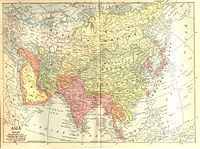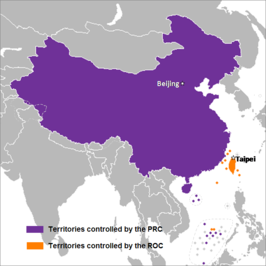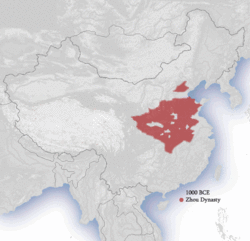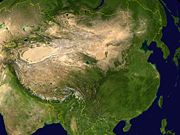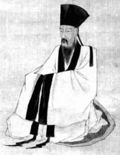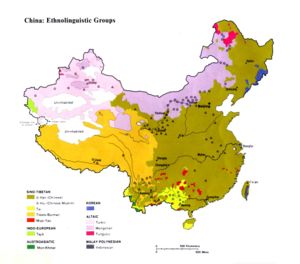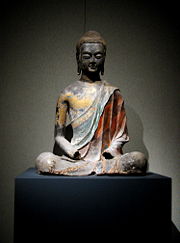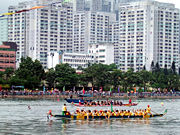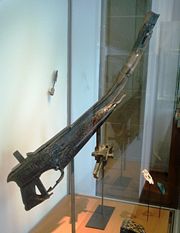China
2008/9 Schools Wikipedia Selection. Related subjects: Asia; Asian Countries
| China | |||||||||||||||||||||||
|---|---|---|---|---|---|---|---|---|---|---|---|---|---|---|---|---|---|---|---|---|---|---|---|
 |
|||||||||||||||||||||||
|
|
|||||||||||||||||||||||
| Traditional Chinese: | 中 國 | ||||||||||||||||||||||
| Simplified Chinese: | 中 国 | ||||||||||||||||||||||
|
|||||||||||||||||||||||
| This article contains Chinese text. Without proper rendering support, you may see question marks, boxes, or other symbols instead of Chinese characters. |
China ( traditional Chinese: 中 國; simplified Chinese: 中 国; Hanyu Pinyin: Zhōngguó ; Tongyong Pinyin: Jhongguó; Wade-Giles ( Mandarin): Chung¹kuo²) is a cultural region, an ancient civilization, and, depending on perspective, a national or multinational entity occupying a large portion of land in East Asia.
China has one of the world's oldest people and continuous civilizations, consisting of states and cultures dating back more than six millennia. It has the world's longest continuously used written language system, and is the source of such major inventions as what the British scholar and biochemist Joseph Needham called the " four great inventions of Ancient China": paper, the compass, gunpowder, and printing. Historically China's cultural sphere has been very influential in East Asia as a whole, with Chinese religion, customs, and writing system being adopted, to varying degrees, by its neighbors Japan, Korea, and Vietnam.
The stalemate of the last Chinese Civil War has resulted in two political entities using the name China: the People's Republic of China (PRC), commonly known as China, which controls mainland China, Hong Kong, and Macau; and the Republic of China (ROC), commonly known as Taiwan, which controls the island of Taiwan and some nearby islands.
Etymology
China is called 'Zhongguo' ( 中國 or 中国) in Chinese. The character zhōng means "middle" or central; the latter, guo, means land, or kingdom.
The name "Zhongguo" appeared first in the Classic of History (6th Century BCE), and was used to refer to the late Zhou Dynasty, as they believed that they were the "centre of civilization" , while peoples in the four cardinals were called Eastern Yi, Southern Man, Western Rong and Northern Di respectively. Some texts imply that "Zhongguo" was originally meant to refer to the capital of the sovereign, to differ from the capital of his vassals. The use of "Zhongguo" implied a claim of political legitimacy. "Zhongguo" was often used by states who saw themselves as the sole legitimate successor to previous Chinese dynasties; for example, in the era of the Southern Song Dynasty, both the Jin Dynasty and the Southern Song state claimed to be "Zhongguo".
"Zhongguo" came to official use as an abbreviation for the Republic of China (Zhonghua Minguo) after the government's establishment in 1912. Since the People's Republic of China, established in 1949, now controls the great majority of area encompassed within the traditional concept of "China", the People's Republic is the political unit most commonly identified with the abbreviated name "Zhongguo".
English and many other languages use various forms of the name "China" and the prefix "Sino-" or "Sin-". These forms are thought to derive from the name of the Qin Dynasty that first unified the country (221–206 BCE). The pronunciation of "Qin" is similar to the phonetic "cheen", which is considered the possible root of the word "China".
History
| History of China | |||||||
|---|---|---|---|---|---|---|---|
| ANCIENT | |||||||
| 3 Sovereigns and 5 Emperors | |||||||
| Xia Dynasty 2100–1600 BCE | |||||||
| Shang Dynasty 1600–1046 BCE | |||||||
| Zhou Dynasty 1122–256 BCE | |||||||
| Western Zhou | |||||||
| Eastern Zhou | |||||||
| Spring and Autumn Period | |||||||
| Warring States Period | |||||||
| IMPERIAL | |||||||
| Qin Dynasty 221 BCE–206 BCE | |||||||
| Han Dynasty 206 BCE–220 CE | |||||||
| Western Han | |||||||
| Xin Dynasty | |||||||
| Eastern Han | |||||||
| Three Kingdoms 220–280 | |||||||
| Wei, Shu & Wu | |||||||
| Jin Dynasty 265–420 | |||||||
| Western Jin | |||||||
| Eastern Jin | 16 Kingdoms 304–439 |
||||||
| Southern & Northern Dynasties 420–589 | |||||||
| Sui Dynasty 581–618 | |||||||
| Tang Dynasty 618–907 | |||||||
| ( Second Zhou 690–705 ) | |||||||
| 5 Dynasties & 10 Kingdoms 907–960 |
Liao Dynasty 907–1125 |
||||||
| Song Dynasty 960–1279 |
|||||||
| Northern Song | W. Xia Dyn. | ||||||
| Southern Song | Jin Dyn. | ||||||
| Yuan Dynasty 1271–1368 | |||||||
| Ming Dynasty 1368–1644 | |||||||
| Qing Dynasty 1644–1911 | |||||||
| MODERN | |||||||
| Republic of China 1912–1949 | |||||||
| People's Republic of China ( Mainland China) 1949–present 1949-1976 |
Republic of China |
||||||
| Dynasties in Chinese History Economic history of China Historiography of China History of Chinese Art History of Education in China History of Science and Technology in China Legal history of China Linguistic history of China Military history of China Naval History of China Timeline of Chinese History |
|||||||
Ancient China was one of the earliest centers of human civilization. Chinese civilization was also one of the few to invent writing independently, the others being Mesopotamia, the Indus Valley Civilization, the Mayan civilization, the Minoan Civilization of ancient Greece, and Ancient Egypt.
Prehistory
Archaeological evidence suggests that the earliest humans in China date from 2.24 million to 250,000 years ago. A cave in Zhoukoudian (near present-day Beijing) has fossils dated at somewhere between 300,000 to 550,000 years.
The earliest evidence of a fully modern human in China comes from Liujiang County, Guangxi, where a cranium has been found and dated to approximately 67,000 years ago. Although much controversy persists over the dating of the Liujiang remains, a partial skeleton from Minatogawa in Okinawa, Japan has been dated to 18,250 ± 650 to 16,600 ± 300 years ago, so modern humans must have reached China before that time.
Dynastic rule
Chinese tradition names the first dynasty Xia, but it was considered mythical until scientific excavations found early bronze-age sites at Erlitou in Henan Province. Archaeologists have since uncovered urban sites, bronze implements, and tombs in locations cited as Xia's in ancient historical texts, but it is impossible to verify that these remains are of the Xia without written records from the period.
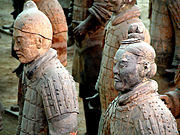
The second dynasty, the loosely feudal Shang, definitely settled along the Yellow River in eastern China from the 18th to the 12th century BCE. They were invaded from the west by the Zhou, who ruled from the 12th to the 5th century BCE. The centralized authority of the Zhou was slowly eroded by warlords. Many strong, independent states continually waged war with each other in the Spring and Autumn period, only occasionally deferring to the Zhou king.
The first unified Chinese state was established by the Qin Dynasty in 221 BCE, when the office of the Emperor was set up and the Chinese language was forcibly standardized. This state did not last long, as its legalist policies soon led to widespread rebellion.
The subsequent Han Dynasty ruled China between 206 BCE and 220 CE, and created a lasting Han cultural identity among its populace that would last to the present day. The Han Dynasty expanded the empire's territory considerably with military campaigns reaching Korea, Vietnam, Mongolia and Central Asia, and also helped establish the Silk Road in Central Asia.
After Han's collapse, another period of disunion followed, including the highly chivalric period of the Three Kingdoms. Independent Chinese states of this period also opened diplomatic relations with Japan, introducing the Chinese writing system there. In 580 CE, China was reunited under the Sui. However, the Sui Dynasty was short-lived after a failure in the Goguryeo-Sui Wars (598–614) weakened it.
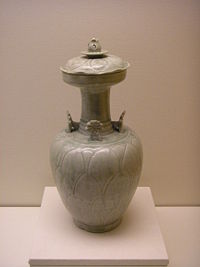
Under the succeeding Tang and Song dynasties, Chinese technology and culture reached its zenith. The Song dynasty was the first government in world history to issue paper money and the first Chinese polity to establish a permanent standing navy. Between the 10th and 11th centuries, the population of China doubled in size. This growth came about through expanded rice cultivation in central and southern China, along with its production of abundant food surpluses. Within its borders, the Northern Song Dynasty had a population of some 100 million people. The Song Dynasty was a culturally rich period in China for the arts, philosophy, and social life. Landscape art and portrait paintings were brought to new levels of maturity and complexity since the Tang Dynasty, and social elites gathered to view art, share their own, and make trades of precious artworks. Philosophers such as Cheng Yi and Chu Hsi reinvigorated Confucianism with new commentary, infused Buddhist ideals, and emphasis on new organization of classic texts that brought about the core doctrine of Neo-Confucianism.
In 1271, the Mongol leader and the fifth Khagan of the Mongol Empire Kublai Khan established the Yuan Dynasty, with the last remnant of the Song Dynasty falling to the Yuan in 1279. A peasant named Zhu Yuanzhang overthrew the Mongols in 1368 and founded the Ming Dynasty. Ming Dynasty thinkers such as Wang Yangming would further critique and expand Neo-Confucianism with ideas of individualism and innate morality that would have tremendous impact on later Japanese thought. Chosun Korea also became a nominal vassal state of Ming China and adopted much of its Neo-Confucian bureaucratic structure. China's capital was moved from Nanjing to Beijing during the early Ming Dynasty. The Ming fell to the Manchus in 1644, who then established the Qing Dynasty. An estimated 25 million people died during the Manchu conquest of Ming Dynasty (1616–1644).
The Qing Dynasty, which lasted until 1912, was the last dynasty in China. In the 19th century the Qing Dynasty adopted a defensive posture towards European imperialism, even though it engaged in imperialistic expansion into Central Asia itself. At this time China awoke to the significance of the rest of the world, in particular the West. As China opened up to foreign trade and missionary activity, opium produced by British India was forced onto Qing China. Two Opium Wars with Britain weakened the Emperor's control.
One result was the Taiping Civil War which lasted from 1851 to 1862. It was led by Hong Xiuquan, who was partly influenced by a misinterpretation of Christianity. Hong believed himself to be the son of God and the younger brother of Jesus. Although the Qing forces were eventually victorious, the civil war was one of the bloodiest in human history, costing at least twenty million lives (more than the total number of fatalities in the First World War), with some estimates up to two-hundred million. In addition, more costly rebellions in terms of human lives and economics followed the Taiping Rebellion such as the Punti-Hakka Clan Wars (1855–1867), Nien Rebellion (1851–1868), Muslim Rebellion (1862–1877), Panthay Rebellion (1856–1873) and the Miao Rebellion (1854–1873). These rebellions resulted in an estimated loss of several million lives for each rebellion and in disastrous results for the economy and the countryside. The flow of British opium led to more decline.
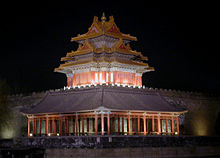
While China was torn by continuous war, Meiji Japan succeeded in rapidly modernizing its military with its sights on Korea and Manchuria. Maneuvered by Japan, Korea declared independence from Qing China's suzerainty in 1894, leading to the First Sino-Japanese War, which resulted in the Qing Dynasty's cession of both Korea and Taiwan to Japan. Following these series of defeats, a reform plan for the empire to become a modern Meiji-style constitutional monarchy was drafted by the Emperor Guangxu in 1898, but was opposed and stopped by the Empress Dowager Cixi, who placed Emperor Guangxu under house arrest in a coup d'état. Further destruction followed the ill-fated 1900 Boxer Rebellion against westerners in Beijing. By the early 20th century, mass civil disorder had begun, and calls for reform and revolution were heard across the country. The 38 year old Emperor Guangxu died under house arrest on November 14, 1908, suspiciously just a day before Cixi. With the throne empty, he was succeeded by Cixi's handpicked heir, his two year old nephew Puyi, who became the Xuantong Emperor, the last Chinese emperor. Guangxu's consort, who became the Empress Dowager Longyu, signed the abdication decree as regent in 1912, ending two thousand years of imperial rule in China. She died, childless, in 1913.
Republic of China (1912–1949)
On January 1, 1912, the Republic of China was established, heralding the end of the Qing Dynasty. Sun Yat-sen of the Kuomintang (the KMT or Nationalist Party) was proclaimed provisional president of the republic. However, the presidency was later given to Yuan Shikai, a former Qing general, who had ensured the defection of the entire Beiyang Army from the Qing Empire to the revolution. In 1915, Yuan proclaimed himself Emperor of China but was forced to abdicate and return the state to a republic when he realized it was an unpopular move, not only with the population but also his own Beiyang Army and its commanders.
After Yuan Shikai's death in 1916, China was politically fragmented, with an internationally recognized but virtually powerless national government seated in Peking (modern day Beijing). Warlords in various regions exercised actual control over their respective territories. In the late 1920s, the Kuomintang, under Chiang Kai-shek, was able to reunify the country under its own control, moving the nation's capital to Nanking (modern day Nanjing) and implementing "political tutelage", an intermediate stage of political development outlined in Sun Yat-sen's program for transforming China into a modern, democratic state. Effectively, political tutelage meant one-party rule by the Kuomintang.
The Sino-Japanese War of 1937–1945 (part of World War II) forced an uneasy alliance between the Nationalists and the Communists as well as causing around 10 million Chinese civilian deaths. With the surrender of Japan in 1945, China emerged victorious but financially drained. The continued distrust between the Nationalists and the Communists led to the resumption of the Chinese Civil War. In 1947, constitutional rule was established, but because of the ongoing Civil War many provisions of the ROC constitution were never implemented on the mainland.
People's Republic of China and Republic of China (1949–present)
After its victory in the Chinese Civil War, the Communist Party of China, led by Mao Zedong, gained control of most of the Mainland China. On October 1, 1949, they established the People's Republic of China as a Socialist State headed by a "Democratic Dictatorship" with the CCP as the only legal political party, thus, laying claim as the successor state of the ROC. The central government of the Chinese Nationalist Party led by Chiang Kai-shek was forced to retreat to the island of Taiwan that it had occupied at the end of World War II and moved the ROC government there. Major armed hostilities ceased in 1950 but no peace treaty has been signed.
Beginning in the late 1970s, the Republic of China began the implementation of full, multi-party, representative democracy in the territories still under its control (Taiwan, and a number of smaller islands including Quemoy and Matsu). Today, the ROC has active political participation by all sectors of society. The main cleavage in ROC politics is the issue of eventual political unification with the Chinese mainland vs. formal independence of Taiwan.
After the Chinese Civil War, mainland China underwent a series of disruptive socioeconomic movements starting in the late 1950s with the Great Leap Forward and continued in the 1960s with the Cultural Revolution that left much of its education system and economy in shambles. With the death of its first generation Communist Party leaders such as Mao Zedong and Zhou Enlai, the PRC began implementing a series of political and economic reforms advocated by Deng Xiaoping that eventually formed the foundation for mainland China's rapid economic development starting in the 1990s.
Post-1978 reforms on the mainland have led to some relaxation of control over many areas of society. However, the PRC government still has almost absolute control over politics, and it continually seeks to eradicate what it perceives as threats to the social, political and economic stability of the country. Examples include the fight against terrorism, jailing of political opponents and journalists, custody regulation of the press, regulation of religion, and suppression of independence/secessionist movements. In 1989, the student protests at Tiananmen Square were violently put to an end by the Chinese military after 15 days of martial law. In 1997, Hong Kong was returned to the PRC by the United Kingdom, and in 1999, Macau was returned by Portugal.
Today, mainland China is administered by the People's Republic of China—a one-party state under the leadership of the Chinese Communist Party; while the island of Taiwan and surrounding islands are administered by the Republic of China—a democratic multi-party state. After the founding of the People's Republic in 1949, both states claimed to be the sole legitimate ruler of all of "China". After the Kuomintang retreat to Taiwan in 1949, the Republic of China had maintained official diplomatic relations with most states around the world, but by the 1970s, there was a shift in the international diplomatic circles and the People's Republic of China gained the upper hand in international diplomatic relations and recognition count. In 1971, under resolution 2758, the representatives of Chiang Kai-shek to the United Nations were expelled from the intergovernmental organization. With the expulsion of the Chiang Kai-shek's representatives, and effectively the Republic of China, the representatives of the People's Republic of China were invited to assume China's seat on the UN Security Council, the UN General Assembly and other United Nations councils and agencies. Later attempts by the Republic of China to rejoin the UN have either been blocked by the People's Republic of China, who has veto power on UN Security Council, or rejected by the United Nations Secretariat or a United Nations General Assembly committee responsible for the General Assembly's agenda.
Since its retreat to Taiwan, the Republic of China has not formally renounced its claim to all of China, nor has it changed its official maps, which includes the mainland and Mongolia. Following the introduction to full democracy and the electoral victory of DPP's Chen Shui-bian in the presidential elections, the Republic of China has not pursued its claims on the mainland and in Mongolia. The previous DPP Administration has adopted a policy of separating the state's identity from "China", while moving towards identifying the state as "Taiwan". The ROC has not made formal moves to change the name, flag, or national anthem of the state to reflect a Taiwan identity due to pressure from the United States and the fear of invasion or military action from the People's Republic of China against the island. The People's Republic of China claims to have succeeded the Republic of China as the sole legitimate governing authority of all of China, which, from the official viewpoint of People's Republic of China, includes the island of Taiwan. Over the last 50 years, both the Republic of China and the People's Republic of China have used diplomatic and economic means to compete for recognition in the international arena. Because most international, intergovernmental organizations observe the One-China policy of the People's Republic of China, the PRC has been able to pressure organizations, such as the World Health Organization and the International Olympic Committee, to refuse official recognition of the Republic of China. Due to the One-China policy, states around the world are pressured to refuse, or to cut off, diplomatic relations with the Republic of China. As a result, 23 U.N. member states currently maintain official diplomatic relations with the Republic of China while the vast majority of the U.N. member states maintain official diplomatic relations with the People's Republic of China.
Territory and environment
Historical political divisions
Top-level political divisions of China have altered as administrations changed. Top levels included circuits and provinces. Below that, there have been prefectures, subprefectures, departments, commanderies, districts, and counties. Recent divisions also include prefecture-level cities, county-level cities, towns and townships.
Most Chinese dynasties were based in the historical heartlands of China, known as China proper. Various dynasties also expanded into peripheral territories like Inner Mongolia, Manchuria, Xinjiang, and Tibet. The Manchu-established Qing Dynasty and its successors, the ROC and the PRC, incorporated these territories into the Chinese empire.
Geography and climate
China ranges from mostly plateaus and mountains in the west to lower lands in the east. Principal rivers flow from west to east, including the Yangtze (central), the Huang He (Yellow river, north-central), and the Amur (northeast), and sometimes toward the south (including the Pearl River, Mekong River, and Brahmaputra), with most Chinese rivers emptying into the Pacific Ocean.
In the east, along the shores of the Yellow Sea and the East China Sea there are extensive and densely populated alluvial plains. On the edges of the Inner Mongolian plateau in the north, grasslands can be seen. Southern China is dominated by hills and low mountain ranges. In the central-east are the deltas of China's two major rivers, the Huang He and Yangtze River. Most of China's arable lands lie along these rivers; they were the centers of China's major ancient civilizations. Other major rivers include the Pearl River, Mekong, Brahmaputra and Amur. Yunnan Province is considered a part of the Greater Mekong Subregion, which also includes Myanmar, Laos, Thailand, Cambodia, and Vietnam.
In the west, the north has a great alluvial plain, and the south has a vast calcareous tableland traversed by hill ranges of moderate elevation, and the Himalayas, containing Earth's highest point, Mount Everest. The northwest also has high plateaus with more arid desert landscapes such as the Takla-Makan and the Gobi Desert, which has been expanding. During many dynasties, the southwestern border of China has been the high mountains and deep valleys of Yunnan, which separate modern China from Burma, Laos and Vietnam.
The Paleozoic formations of China, excepting only the upper part of the Carboniferous system, are marine, while the Mesozoic and Tertiary deposits are estuarine and freshwater or else of terrestrial origin. Groups of volcanic cones occur in the Great Plain of north China. In the Liaodong and Shandong Peninsulas, there are basaltic plateaus.
The climate of China varies greatly. The northern zone (containing Beijing) has summer daytime temperatures of more than 30 degrees Celsius and winters of Arctic severity. The central zone (containing Shanghai) has a temperate continental climate with very hot summers and cold winters. The southern zone (containing Guangzhou) has a subtropical climate with very hot summers and mild winters.
Due to a prolonged drought and poor agricultural practices, dust storms have become usual in the spring in China. Dust has blown to southern China and Taiwan, and has reached the West Coast of the United States. Water, erosion, and pollution control have become important issues in China's relations with other countries.
Economy
Society
Culture
Confucianism was the official philosophy throughout most of Imperial China's history, and mastery of Confucian texts was the primary criterion for entry into the imperial bureaucracy. China's traditional values were derived from various versions of Confucianism. A number of more authoritarian strains of thought have also been influential, such as Legalism. There was often conflict between the philosophies, e.g. the Song Dynasty Neo-Confucians believed Legalism departed from the original spirit of Confucianism. Examinations and a culture of merit remain greatly valued in China today. In recent years, a number of New Confucians (not to be confused with Neo-Confucianism) have advocated that democratic ideals and human rights are quite compatible with traditional Confucian "Asian values".
With the rise of Western economic and military power beginning in the mid-19th century, non-Chinese systems of social and political organization gained adherents in China. Some of these would-be reformers totally rejected China's cultural legacy, while others sought to combine the strengths of Chinese and Western cultures. In essence, the history of 20th century China is one of experimentation with new systems of social, political, and economic organization that would allow for the reintegration of the nation in the wake of dynastic collapse.
Arts, scholarship, and literature
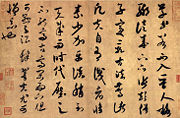
Chinese characters have had many variants and styles throughout Chinese history. Tens of thousands of ancient written documents are still extant, from Oracle bones to Qing edicts. This literary emphasis affected the general perception of cultural refinement in China, e.g. the view that calligraphy was a higher art form than painting or drama. Manuscripts of the Classics and religious texts (mainly Confucian, Taoist, and Buddhist) were handwritten by ink brush. Calligraphy later became commercialized, and works by famous artists became prized possessions.
Chinese literature has a long past; the earliest classic work in Chinese, the I Ching or "Book of Changes" dates to around 1000 BCE. A flourishing of philosophy during the Warring States Period produced such noteworthy works as Confucius's Analects and Laozi's Tao Te Ching. (See also the Chinese classics.) Dynastic histories were often written, beginning with Sima Qian's seminal Records of the Historian written from 109 BCE to 91 BCE. The Tang Dynasty witnessed a poetic flowering, while the Four Great Classical Novels of Chinese literature were written during the Ming and Qing Dynasties.
Printmaking in the form of movable type was developed during the Song Dynasty. Academies of scholars sponsored by the empire were formed to comment on the classics in both printed and handwritten form. Royalty frequently participated in these discussions as well. The Song Dynasty was also a period of great scientific literature, such as Su Song's Xin Yixiang Fayao and Shen Kuo's Dream Pool Essays. There were also enormous works of historiography and large encyclopedias, such as Sima Guang's Zizhi Tongjian of 1084 CE or the Four Great Books of Song fully compiled and edited by the 11th century.
For centuries, economic and social advancement in China could be provided by high performance on the imperial examinations. This led to a meritocracy, although it was available only to males who could afford test preparation. Imperial examinations required applicants to write essays and demonstrate mastery of the Confucian classics. Those who passed the highest level of the exam became elite scholar-officials known as jinshi, a highly esteemed socio-economic position.
Chinese philosophers, writers and poets were highly respected and played key roles in preserving and promoting the culture of the empire. Some classical scholars, however, were noted for their daring depictions of the lives of the common people, often to the displeasure of authorities.
The Chinese invented numerous musical instruments, such as the zheng (zither with movable bridges), qin (bridgeless zither), sheng (free reed mouth organ), and xiao (vertical flute) and adopted and developed others such the erhu (alto fiddle or bowed lute) and pipa (pear-shaped plucked lute), many of which have later spread throughout East Asia and Southeast Asia, particularly to Japan, Korea, and Vietnam.
Demography
Hundreds of ethnic groups have existed in China throughout its history. The largest ethnic group in China by far is the Han. This group is diverse in itself and can be divided into smaller ethnic groups that share some traits.
Over the last three millennia, many previously distinct ethnic groups in China have been Sinicized into a Han identity, which over time dramatically expanded the size of the Han population. However, these assimilations were usually incomplete and vestiges of indigenous language and culture often are still retained in different regions of China. Because of this, many within the Han identity have maintained distinct linguistic and cultural traditions, though still identifying as Han. Several ethnicities have also dramatically shaped Han culture, e.g. the Manchurian clothing called the qipao became the new "Chinese" fashion after the 17th century, replacing earlier Han styles of clothing such as the Hanfu. The modern term Chinese nation (Zhonghua Minzu) is now used to describe a notion of a Chinese nationality that transcends ethnic divisions.
Languages
Most languages in China belong to the Sino-Tibetan language family, spoken by 29 ethnicities. There are also several major dialects within the Chinese language itself. The most spoken dialects are Mandarin (spoken by over 70% of the population), Wu (Shanghainese), Yue (Cantonese), Min, Xiang, Gan, and Hakka. Non-Sinitic languages spoken widely by ethnic minorities include Zhuang (Thai), Mongolian, Tibetan, Uyghur (Turkic), Hmong and Korean.
Classical Chinese was the written standard used for thousands of years in China before the 20th century and allowed for written communication between speakers of various unintelligible languages and dialects in China. Vernacular Chinese or baihua is the written standard based on the Mandarin dialect first popularized in Ming dynasty novels and was adopted (with significant modifications) during the early 20th century as the national vernacular. Classical Chinese is still part of the high school curriculum and is thus intelligible to some degree to many Chinese.
Religion
The "official" orthodox faith system held by most dynasties of China until the overthrow of the last dynasty is a panentheism system, centering on the worship of " Heaven" as an omnipotent force. This faith system pre-dated the development of Confucianism and Taoism or the introduction of Buddhism and Christianity. It has features of a monotheism in that Heaven is seen as an omnipotent entity, endowed with personality but no corporeal form. "Heaven" as a supernatural force was variously referred to as Shangdi (literally "Emperor Above"). Worship of Heaven includes the erection of shrines, the last and greatest being the Altar of Heaven in Beijing, and the offering of prayers. Manifestation of the powers of Heaven include weather and natural disasters. Although it gradually diminished in popular belief after the advent of Taoism and Buddhism, among others, some of its concepts remained in use throughout the pre-modern period and have been incorporated in later religions of China.
Taoism is an indigenous religion of China and is traditionally traced to the composition of Lao Zi's Tao Te Ching (The Book of Tao and Its Virtues) or to seminal works by Zhang Daoling. The philosophy of Taoism is centered on " the way"; an understanding of which can be likened to recognizing the true nature of the universe. Taoism in its unorganized form is also considered a folk religion of China. More secular derivatives of Taoist ideas include Feng Shui, Sun Tzu's Art of War, and acupuncture.
Buddhism was introduced from India and Central Asia during the Han dynasty and became very popular among Chinese of all walks of life, embraced particularly by commoners, and sponsored by emperors in certain dynasties. Mahayana (大乘, Dacheng) is the predominant form of Buddhism practiced in China, where it was largely Sinicized and later exported to Korea, Japan and Vietnam. Some subsets of Mahayana popular in China include Pure Land ( Amidism) and Zen. Buddhism is the largest organized faith in China and the country has the most Buddhist adherents in the world, followed by Japan. Many Chinese, however, identify themselves as both Taoist and Buddhist at the same time.
Ancestor worship is a major religious theme shared among all Chinese religions. Traditional Chinese culture, Taoism, Confucianism, and Chinese Buddhism all value filial piety as a top virtue, and the act is a continued display of piety and respect towards departed ancestors. The Chinese generally offer prayers and food for the ancestors, light incense and candles, and burn offerings of Joss paper. These activities are typically conducted at the site of ancestral graves or tombs, at an ancestral temple, or at a household shrine.
Islam, Judaism and Christianity first arrived in China after the 7th century during the Tang Dynasty. Islam was later spread by merchants and craftsmen as trade routes improved along the Silk Road, while Christianity began to make significant inroads in China after the 16th century through Jesuit and later protestant missionaries. Islam arrived in China during the 8th century, only a few years after the Islamic prophet Muhammad's death. The Emperor of China took Islam highly, and the first mosque in China, the Huaisheng Mosque was built in Canton, Guangzhou in 630. In the first half of the 20th century, many Jews arrived in Shanghai and Hong Kong during those cities' periods of economic expansion, seeking refuge from the Holocaust in Europe. Shanghai was particularly notable for its volume of Jewish refugees, as it was the only port in the world then to accept them without an entry visa.
Sports and recreation
Many historians believe that football (soccer) originated in China, where a form of the sport may have appeared around 1000 CE. Other popular sports include martial arts, table tennis, badminton, and more recently, golf. Basketball is now popular among young people in urban centers.
There are also many traditional sports. Chinese dragon boat racing occurs during the Duan Wu festival. In Inner Mongolia, Mongolian-style wrestling and horse racing are popular. In Tibet, archery and equestrian sports are part of traditional festivals.
Physical fitness is highly regarded. It is common for the elderly to practice Tai Chi Chuan and qigong in parks.
Board games such as International Chess, Go (Weiqi), and Xiangqi (Chinese chess) are also common and have organized formal competitions. China is also due to host the Olympic Games this year in their capital Beijing.
Science and technology
Among the scientific accomplishments of ancient China were paper (not papyrus) and papermaking, woodblock printing and movable type printing, the early lodestone and magnetic compass, gunpowder, toilet paper, early seismological detectors, matches, dry docks, pound locks, sliding calipers, the double-action piston pump, blast furnace and cast iron, the iron plough, the multi-tube seed drill, the wheelbarrow, the suspension bridge, the parachute, natural gas as fuel, the escapement mechanism for clocks, the differential gear for the South Pointing Chariot, the hydraulic-powered armillary sphere, the hydraulic-powered trip hammer, the mechanical chain drive, the mechanical belt drive, the raised-relief map, the propeller, the crossbow, the cannon, the rocket, the multistage rocket, etc. Chinese astronomers were among the first to record observations of a supernova. The work of the astronomer Shen Kuo (1031–1095) alone was most impressive, as he theorized that the sun and moon were spherical, corrected the position of the polestar with his improved sighting tube, discovered the concept of true north, wrote of planetary motions such as retrogradation, and compared the orbital paths of the planets to points on the shape of a rotating willow leaf. With evidence for them, he also postulated geological theories for the processes of land formation in geomorphology and climate change in paleoclimatology. Yet there were many other astronomers than Shen Kuo, such as Gan De, Shi Shen, Zhang Heng, Yi Xing, Zhang Sixun, Su Song, Guo Shoujing, Xu Guangqi, etc. Chinese mathematics evolved independently of Greek mathematics and is therefore of great interest in the history of mathematics. The Chinese were also keen on documenting all of their technological achievements, such as in the Tiangong Kaiwu encyclopedia written by Song Yingxing (1587–1666).
China's science and technology fell behind that of Europe by the 17th century. Political, social and cultural reasons have been given for this, although recent historians focus more on economic causes, such as the high level equilibrium trap. Since the PRC's market reforms China has become better connected to the global economy and is placing greater emphasis on science and technology.

